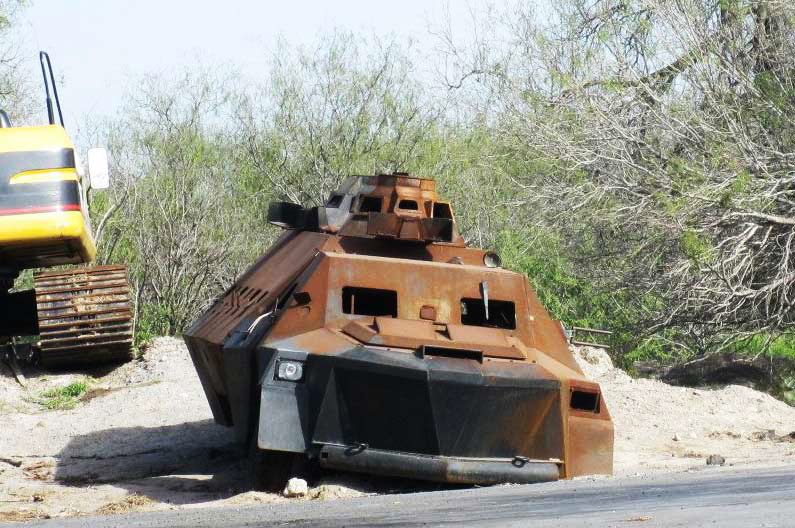
As Mexican gangsters shot it out with troops in the border city of Reynosa this month, residents posted warnings on social media of where not to drive. Not only was the gunfire itself a problem but cartel gunmen had covered some roads with perilous spikes that they call ponchallantas or “tire punchers.” The hazard can appear suddenly as the cartels have customized vans with tubes that eject the spikes. If a car drives into them too fast, it can spin into a lethal crash. Gangsters also set grounded vehicles on fire, creating more debris in the way of security forces.
The tire punchers used in the April 17 firefight, in which soldiers arrested an alleged kingpin called José Tiburcio Hernández, are the latest example of the homemade battle technology developed by Mexico’s cartels. Gangsters have also built fighting vehicles with four inch-thick armor, sometimes referred to as “monsters” or “narco tanks.” And in October, police in the western state of Jalisco even busted a clandestine factory where traffickers assembled their own assault rifles.
The development of this narco technology south of the Rio Grande has grabbed the attention of U.S. security thinkers such as Robert Bunker, an external researcher for the U.S. Army War College. He compares it to the homemade war tools used by insurgent forces round the world. “Each battle technology has been adapted to both the conflict environment and the ideological and illicit economic motivations of the irregular forces,” Bunker says. “Caltrops and spike traps have been a component of warfare going back to the ancient Greeks. In many ways, we can think of them as pre-modern landmines.”
While there is no declared war in Mexico, fighting between rival cartels and the security forces has claimed more than 83,000 lives since 2007, according to a count by Mexico’s federal intelligence agency. Gangsters use traditional weapons, including Kalashnikovs, which are often smuggled from the United Sates. The Bureau of Alcohol Tobacco and Firearms has traced 73,684 guns seized in Mexico to U.S. gun sellers since 2009. Cartels also have rocket-propelled grenades, which may be stolen from Central American military caches.
However, it is harder for them to buy actual military vehicles leading to them inventing their own. The Zetas cartel, which was led by former soldiers, first developed its own armored vehicles, both converting regular trucks and building others from scratch. Their “monsters” resemble machines from the fantasy road wars of Mad Max, with gun turrets, battering rams and walls of armor.
The Mexican army has taken many of these makeshift tanks off the road, holding more than 40 of them in its base in Reynosa. But some are still at large and causing havoc. Last year, a Zeta monster attacked a hotel in the border town of Ciudad Mier, where executives from the oil services multinational Weatherford were staying. (The executives were shaken but unscathed).
Furthermore, vigilante groups that formed to fight cartels also built their own armored vehicles. “We were going into heavy gunfire and we needed protection. So we made these monsters of our own, based on the vehicles that the Zetas had built,” said Francisco Espinosa, a cattle rancher turned vigilante. With the help of local metal workers, they also used thick layers of armor, and added some of their own features such as mobile sand trenches.
The gun factory busted in October belonged to rising gang called the Jalisco New Generation Cartel. The cartel has gained infamy for a series of attacks on Mexican officials, including an ambush on April 7 that killed 15 policemen. Hidden in two farm houses in the tequila-producing region, the factory used industrial metal cutters and blow torches to assemble AR15 rifles from components. “It’s highly sophisticated machinery with very precise software that allows them to make the cuts to finish the guns, which work perfectly,” Jalisco Attorney General Luis Carlos Najera said.
The factory likely uses gun parts that are sold on line, producing untraceable AR15’s, says Bunker, the security scholar. “I consider it conceptually sophisticated but not technologically sophisticated. The next step in this process will be the addition of a 3D metal printer. I’m sure this will come in time as more of these improvised arms factories spring up, metal printer technology matures, and prices for them drop.”
The cartels’ ability to make their own guns, customized vehicles and spike ejectors make them difficult for Mexico’s government to wipe out. Under President Enrique Pena Nieto, troops have arrested a string of cartel leaders, including the head of the Zetas and Sinaloan chief Joaquin “Chapo” Guzman. This has helped reduce the total number of homicides, which went down from a peak of more than 22,000 in 2011 to 15,649 last year, according to a police count. But incidents such as the chaos in Reynosa and ambushes in Jalisco continue to shake the nation.
Bunker warns that cartels may keep on developing their battle tech. They could use drones for surveillance in the near future, giving them a fighting edge. Mexican gangsters have also used small car bombs, and could potentially harness bigger improvised explosive devices like those in the Middle East. “One area that we should keep an eye on is car bomb and IED use potentials,” Bunker says. “I could envision IEDs being placed in a city or town under certain circumstances.”
More Must-Reads From TIME
- The 100 Most Influential People of 2024
- Coco Gauff Is Playing for Herself Now
- Scenes From Pro-Palestinian Encampments Across U.S. Universities
- 6 Compliments That Land Every Time
- If You're Dating Right Now , You're Brave: Column
- The AI That Could Heal a Divided Internet
- Fallout Is a Brilliant Model for the Future of Video Game Adaptations
- Want Weekly Recs on What to Watch, Read, and More? Sign Up for Worth Your Time
Contact us at letters@time.com